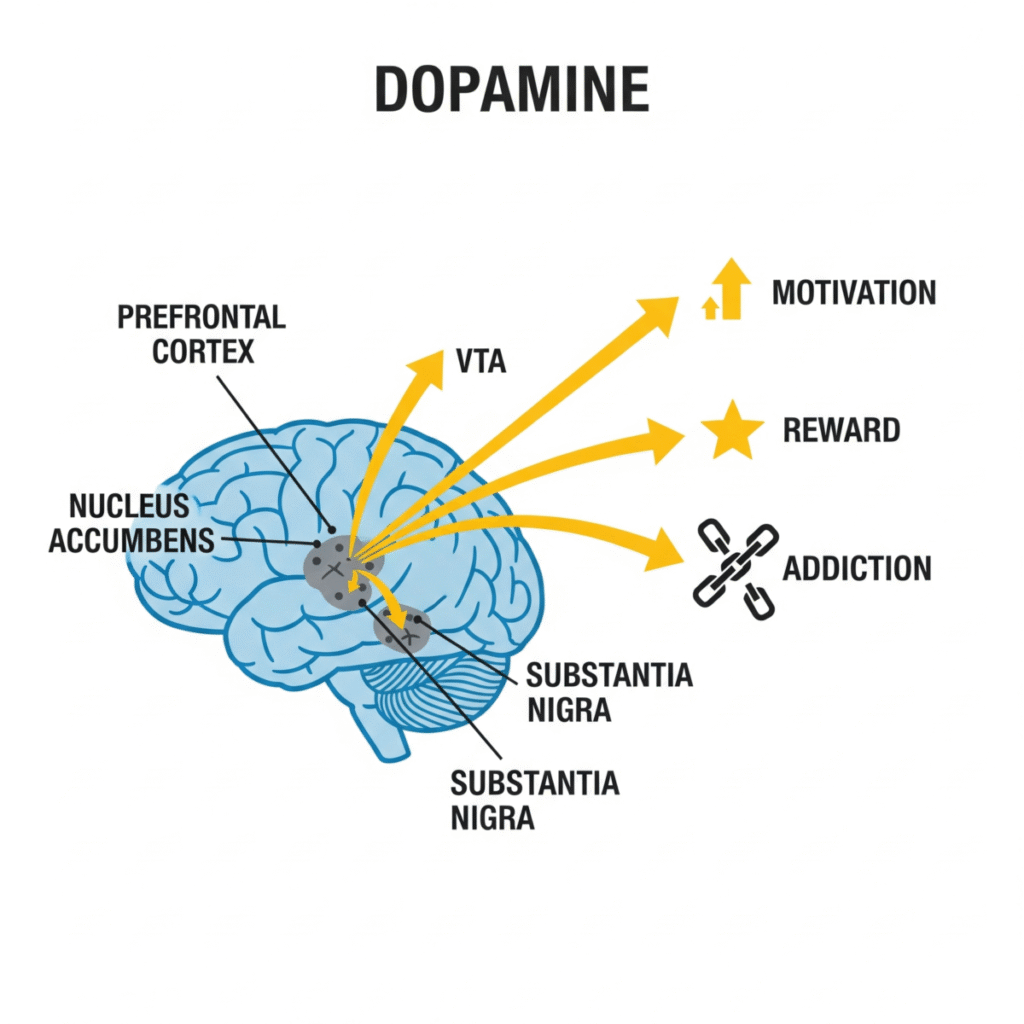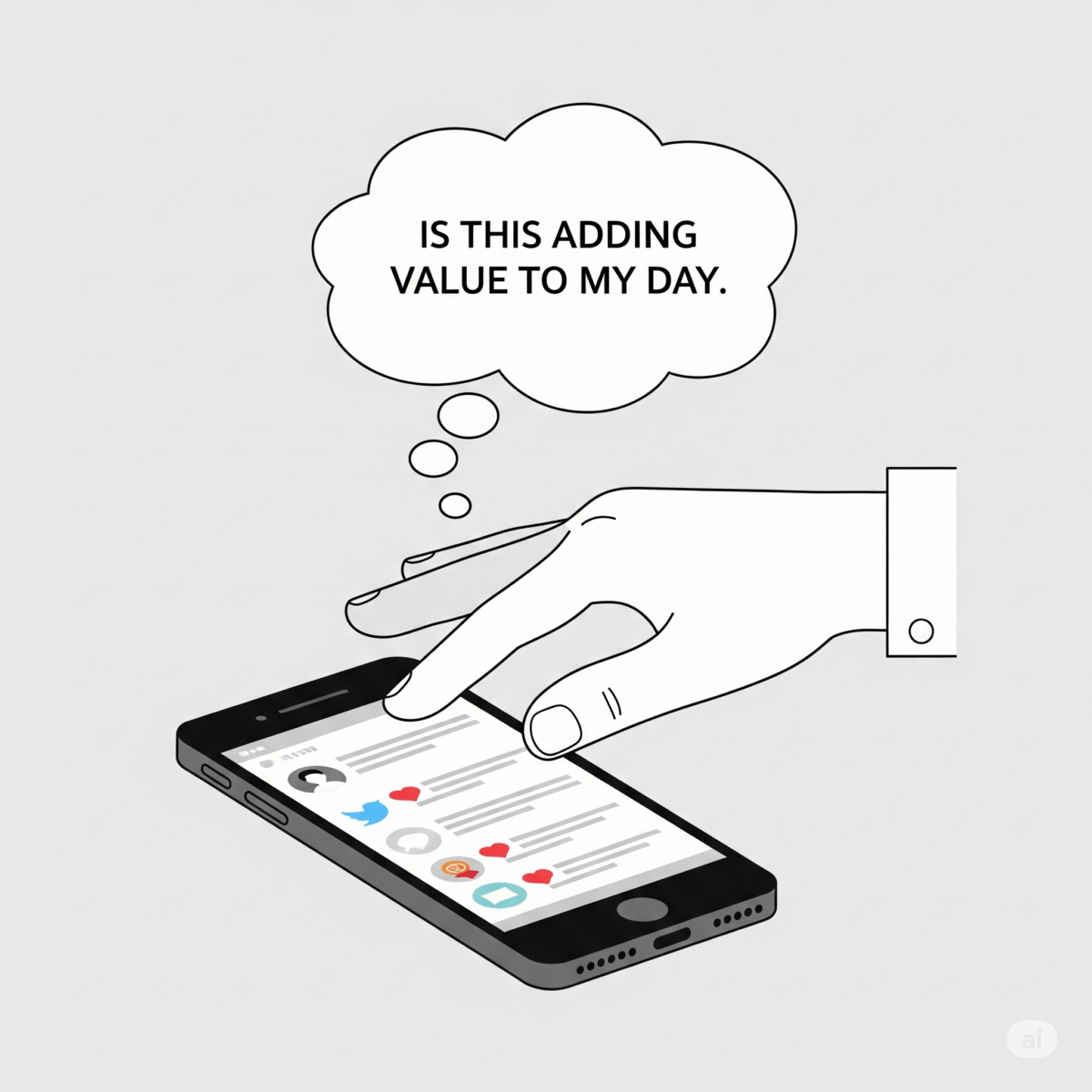Your friend’s guide to separating fact from fiction in the latest wellness trend
Hey there! Have you been seeing those dopamine detox videos everywhere lately? You know the ones – influencers sitting in empty rooms, staring at walls, claiming they’re “resetting their brain chemistry” for ultimate productivity and happiness.
I get it. The promise sounds incredible: just avoid certain activities for a few days, and boom – laser focus, boundless motivation, and inner peace. But as your science-loving friend, I had to dig deeper. Is dopamine detox the real deal, or are we all falling for another viral wellness myth?
Let’s unpack this together, because the truth is way more interesting (and practical) than what’s trending on TikTok.
What Actually Is Dopamine? (Spoiler: It’s Not Evil)
Before we dive into dopamine detox, let’s get one thing straight – dopamine isn’t some toxic villain we need to flush out of our system. Think of dopamine as your brain’s personal motivational coach, not just a “pleasure chemical.”
This neurotransmitter is actually responsible for helping you pursue goals, stay focused, and feel motivated to tackle your to-do list. It’s involved in everything from remembering where you left your keys to feeling excited about your weekend plans.
Here’s where it gets interesting: dopamine spikes happen before you get what you want, not after. That little buzz you feel when your phone lights up? That’s dopamine saying “hey, something good might be coming!” It’s the same system that helped our ancestors stay motivated to hunt for food or find shelter.
Dr. Andrew Huberman, a neuroscientist at Stanford, explains it perfectly – dopamine is about the pursuit of rewards, not just receiving them. So when people talk about “dopamine addiction,” they’re really talking about getting stuck in unhelpful habit loops, not being chemically dependent on a brain chemical we literally need to survive.

Boosting Well-Being Beyond Dopamine
While managing attention and habits is key to focus, another powerful approach lies in tapping into your body’s natural stress response. Techniques that stimulate the vagus nerve, like deep breathing or cold exposure, can enhance calm, resilience, and mental clarity. For a deeper dive into these methods and their science-backed benefits, check out our article: “Vagus Nerve Stimulation Benefits”.
The Real Story Behind Dopamine Detox
Here’s something most influencers won’t tell you: dopamine detox wasn’t invented by a life coach or productivity guru. It actually comes from Dr. Cameron Sepah, a clinical psychologist who developed something called “dopamine fasting” as a legitimate therapy technique.
But here’s the kicker – Dr. Sepah’s original method was never about “detoxing from dopamine.” It was designed to help people break compulsive behaviors by temporarily avoiding specific triggers. Think of it like giving yourself space from that bag of chips when you’re trying to eat healthier, not because chips are evil, but because taking a break helps reset your habits.
Somehow, social media transformed this targeted behavioral therapy into “quit all dopamine for ultimate brain optimization!” And honestly? That’s like saying you need to stop breathing to improve your lung health. It just doesn’t make scientific sense.
The original dopamine detox focused on avoiding specific behaviors like compulsive social media scrolling, gaming, or emotional eating – not eliminating an essential brain chemical that keeps you alive and functioning.
How Social Media Turned Therapy Into Trendy Content
Let me paint you a picture of how we got here. Platforms like TikTok and YouTube love extreme content because it gets clicks. “Take a mindful break from your phone” doesn’t sound nearly as dramatic as “I QUIT DOPAMINE for 30 DAYS – YOU WON’T BELIEVE WHAT HAPPENED!”
I’ve seen videos of people sitting in completely empty rooms, avoiding eye contact, refusing to listen to music, and calling it a dopamine detox. Some influencers promote routines that include cold showers at 4 AM, zero social interaction, and eating the blandest foods possible – all in the name of “resetting their brain chemistry.”
The aesthetic appeal is undeniable. There’s something attractive about the minimalist, monk-like imagery, especially when it’s packaged with promises of becoming a productivity superhuman. It taps into our desire for quick fixes and dramatic transformations.
But here’s the thing – most of these extreme routines have nothing to do with dopamine and everything to do with creating engaging content. The more extreme and unusual the behavior, the more likely it is to go viral.

The Real Psychology Behind Why We Feel Overstimulated
Okay, let’s talk about what’s actually happening when you feel scattered, unfocused, or constantly craving the next digital hit. It’s not dopamine poisoning – it’s habit hijacking.
Our brains are incredibly good at learning patterns. When you get a notification, check your phone, and feel a microburst of satisfaction, that behavior becomes reinforced. Over time, your brain learns to chase that tiny hit. It’s not because dopamine is bad – it’s because the dopamine detox trend has oversimplified a very complex reward system.
What we often need is not to eliminate dopamine, but to reset our dopamine detox strategy – by changing our environment, breaking behavior loops, and reintroducing mindfulness.
Many experts suggest that healthy dopamine regulation comes from moderation, not restriction. In that sense, a dopamine detox can be helpful — but only if approached with awareness, not extremism.find something interesting (a like, a message, a funny meme), your brain notes this sequence: cue → action → reward. Over time, just seeing your phone becomes enough to trigger the urge to check it.
James Clear talks about this brilliantly in “Atomic Habits” – it’s not that technology is inherently evil, but that it’s designed to create very strong habit loops. Every app notification, every infinite scroll feed, every “you have a new match” alert is engineered to capture and hold your attention.
Cal Newport, in “Digital Minimalism,” explains how this constant switching between tasks fragments our attention span. It’s not that your dopamine system is broken – it’s that you’ve trained it to expect constant stimulation and immediate rewards.
The solution isn’t to eliminate dopamine (impossible and dangerous). It’s to be more intentional about which habits you’re reinforcing and which distractions you’re allowing into your mental space.
Dive Deeper: A Dopamine Detox That Supports Focus
If you’re interested in how a moderated approach to dopamine detox can genuinely boost concentration, check out our dedicated guide on using mindful breaks to sharpen productivity. In our article, “Dopamine Detox for Focus”, we explore science-backed techniques that align with intentional habit-building—not extreme deprivation—to help your brain maintain clarity and resilience.

Does Dopamine Detox Actually Work? The Science Says…
Here’s where I’m going to be your reality-check friend: there’s zero scientific evidence that you can “reset” your dopamine levels through temporary abstinence. Your brain doesn’t work like a computer that needs to be rebooted.
However – and this is important – many people do report feeling more focused and less scattered after taking breaks from highly stimulating activities. So what’s actually happening?
The benefits likely come from:
- Reduced decision fatigue: Fewer choices about what to scroll, watch, or click
- Improved attention span: Less practice task-switching means better focus
- Increased awareness: When you’re not constantly distracted, you notice more about your thoughts and feelings
- Better sleep: Less screen time, especially before bed, can improve rest quality
Think of it like this: if you’ve been eating candy all day, an apple is going to taste pretty amazing. It’s not that you’ve “detoxed” your taste buds – you’ve just given them a break from intense sweetness so they can appreciate subtler flavors again.
The same principle applies to attention and focus. Take a break from highly stimulating activities, and suddenly reading a book or having a conversation feels more engaging and satisfying.
🧠 Clinical Origins of Dopamine Detox
Most people don’t realize that the concept of dopamine detox didn’t originate from social media influencers, but from clinical psychology. Dr. Cameron Sepah, a licensed psychologist and professor at UCSF, originally introduced the idea as a tool to manage compulsive behaviors — not to eliminate dopamine itself. His original intent was rooted in cognitive behavioral therapy (CBT), and not the extreme no-stimulation challenges trending online. You can explore Dr. Sepah’s original article on dopamine fasting on Medium, where he explains how behavioral triggers—not brain chemicals—are the real target.
Red Flags and Myths to Watch Out For
As your concerned friend, I need to call out some dangerous myths floating around the dopamine detox community:
Myth 1: “You can flush dopamine out of your system” ❌ Nope. Dopamine is produced by your brain constantly. You literally need it to move, think, and stay alive.
Myth 2: “Dopamine is bad and addictive” ❌ Dopamine itself isn’t addictive. It’s part of learning and motivation systems that can be hijacked by certain behaviors or substances.
Myth 3: “You must suffer to reset your brain” ❌ Extreme deprivation isn’t necessary and can actually increase anxiety and obsessive thinking about the things you’re avoiding.
Myth 4: “30 days of detox will permanently change your brain” ❌ Behavior change takes consistent practice over time, not dramatic short-term restrictions.
I’m genuinely worried about some of the extreme protocols I see online. Completely isolating yourself, refusing all pleasurable activities, or feeling guilty about enjoying things can actually worsen anxiety and create an unhealthy relationship with normal human experiences.
If you find yourself feeling anxious, guilty, or obsessive about avoiding certain activities, that’s a sign to ease up and maybe talk to someone you trust.
📚 Expert Insight on Dopamine from Neuroscience
If you’re curious about what real neuroscience says about dopamine, Dr. Andrew Huberman, a professor of neurobiology at Stanford University, has explained it in depth. According to his research, dopamine isn’t just about pleasure — it’s primarily about motivation and the pursuit of rewards. You can read more about his insights in this detailed article from the Huberman Lab which breaks down how dopamine works in daily life and how to manage it without falling for myths like extreme dopamine detox routines.
A Balanced, Science-Based Approach (That Actually Works)
Okay, so if extreme dopamine detox isn’t the answer, what is? I’m glad you asked! Here’s what actually works, backed by research and common sense:
Instead of “detoxing from dopamine,” focus on dopamine detox alternatives like dopamine discipline – being more intentional about your habits and attention.
Try these evidence-based strategies:
- Digital boundaries: Use screen time limits, put your phone in another room during focused work, or designate phone-free meals.
- Mindful consumption: Ask yourself “Is this adding value to my day?” before opening apps or turning on shows.
- Single-tasking practice: Do one thing at a time with full attention – whether it’s eating, working, or talking with friends.
- Nature breaks: Spend 20 minutes outside without your phone. Your brain loves natural stimulation, and it’s a better reset than any extreme dopamine detox routine.
- Sleep hygiene: Stop scrolling at least an hour before bed. Your brain needs time to wind down.
The key is consistency over extremes. Small, sustainable changes beat dramatic 30-day dopamine detox challenges every time.
Your Friend’s Bottom Line: Science Over Sensationalism
Look, I get why dopamine detox is appealing. We all feel overwhelmed by constant notifications, endless content, and the pressure to be “on” all the time. The desire for a simple solution to reclaim our focus and peace of mind is completely understandable.
But here’s what I want you to remember: dopamine isn’t your enemy. It’s an essential part of how your brain motivates you to pursue goals, connect with others, and find meaning in your daily life.
The real problem isn’t dopamine – it’s that we’re living in an environment designed to constantly grab our attention and keep us engaged with digital content. The solution isn’t to eliminate a crucial brain chemical, but to be more thoughtful about what we’re paying attention to.
The science is clear:
- Dopamine is essential for motivation, focus, and well-being.
- You can’t “detox” from a neurotransmitter your brain produces naturally — dopamine detox as a literal concept is misleading.
- Behavior change through mindful habits works better than extreme restrictions.
- Taking breaks from overstimulating activities can help you feel more focused and present — which is what most dopamine detox routines are really trying (and failing) to achieve.

Instead of chasing the latest wellness trend, invest in building sustainable habits that support your mental clarity and overall well-being. Your future self will thank you for choosing science-backed strategies over social media hype.
Frequently Asked Questions about Dopamine Detox
What is a dopamine detox?
A dopamine detox is a practice where people temporarily abstain from pleasurable activities like social media, video games, or junk food to reset their brain’s reward system. However, it’s a misnomer since you can’t actually detox from dopamine—a naturally occurring brain chemical.
Is dopamine detox scientifically proven?
No, the concept of “detoxing” from dopamine is not supported by neuroscience. But practicing digital minimalism, mindfulness, and focused attention can lead to better mental clarity and productivity.
What are the real benefits of dopamine detox?
While you can’t detox from dopamine itself, limiting overstimulating behaviors can help improve focus, sleep, mental health, and self-discipline.
How long should a dopamine detox last?
There’s no set duration. For some, a few hours of mindful disconnection daily is enough. For others, a full weekend offline can help reset attention and build discipline.
What are better alternatives to extreme detoxes?
Science-backed habits like setting digital boundaries, getting quality sleep, practicing mindfulness, and spending time in nature are more effective and sustainable alternatives to dopamine detox extremes.
Take Action: Your Mindful Reset Toolkit
Ready to try a science-smart approach? Here are some practical tools to get started — no fake dopamine detox rituals required:
⏰ The 20-20-20 Rule: Every 20 minutes, look at something 20 feet away for 20 seconds. Gives your brain a micro-break from screen focus.
📓 Urge Surfing: When you feel the impulse to check your phone or scroll mindlessly, pause and notice the feeling without immediately acting on it. It’s a psychological tactic that works better than any dopamine detox shortcut.
🌱 Green Time: Spend at least 20 minutes outside daily without digital devices. Nature is incredibly restorative for attention and mood, and unlike a full dopamine detox, it’s actually sustainable.
🎯 One-Task Focus: Pick one important task and do it without switching to anything else for 25–30 minutes. Deep work, not a dramatic dopamine detox, is the real productivity booster.
💤 Digital Sunset: Stop using screens 1 hour before your intended bedtime. Read, journal, or have a real conversation instead. Sleep benefits more from this than any supposed dopamine detox ban.
Remember, the goal isn’t perfection – it’s progress. Small, consistent changes in how you manage your attention and habits will serve you much better than any extreme dopamine detox protocol.
Your brain doesn’t need to be reset. It just needs to be treated with a little more intentionality and care. And honestly? That’s way more achievable (and sustainable) than quitting dopamine.
Want more science-backed wellness tips that actually work?
Health Morph is here to help you navigate the world of health trends with evidence, not hype. Because your well-being deserves better than viral misinformation — and definitely better than misunderstood ideas like dopamine detox.






Leave a Reply